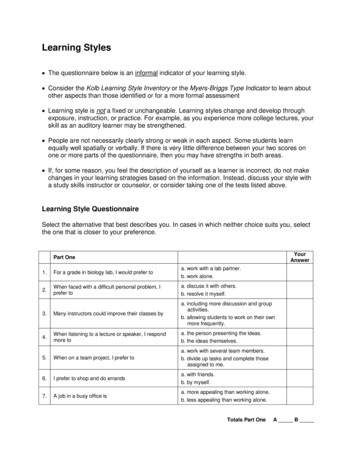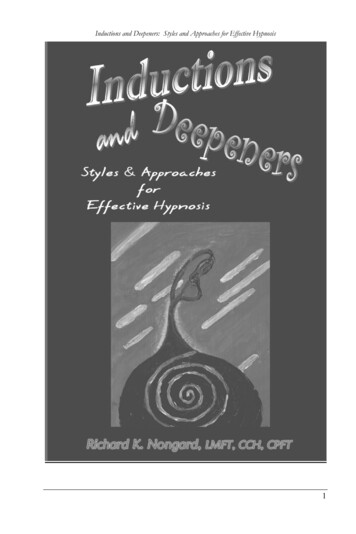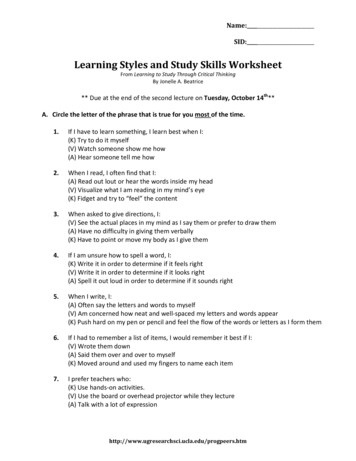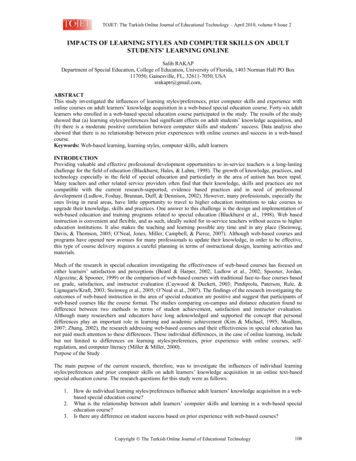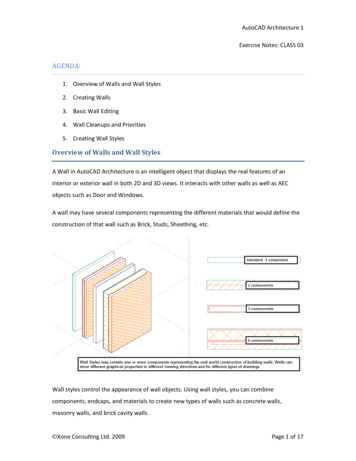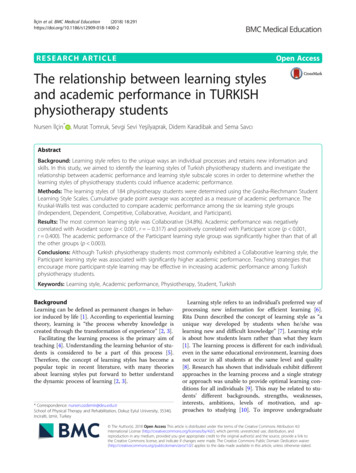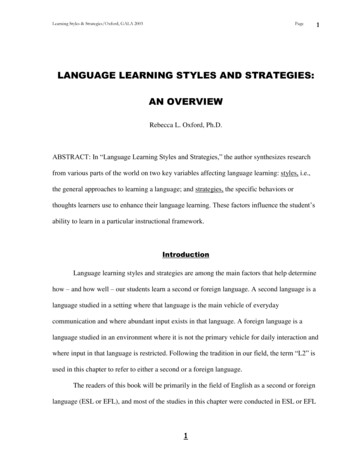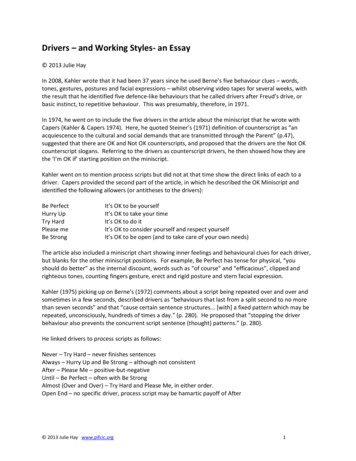
Transcription
Drivers – and Working Styles- an Essay 2013 Julie HayIn 2008, Kahler wrote that it had been 37 years since he used Berne’s five behaviour clues – words,tones, gestures, postures and facial expressions – whilst observing video tapes for several weeks, withthe result that he identified five defence-like behaviours that he called drivers after Freud’s drive, orbasic instinct, to repetitive behaviour. This was presumably, therefore, in 1971.In 1974, he went on to include the five drivers in the article about the miniscript that he wrote withCapers (Kahler & Capers 1974). Here, he quoted Steiner’s (1971) definition of counterscript as “anacquiescence to the cultural and social demands that are transmitted through the Parent” (p.47),suggested that there are OK and Not OK counterscripts, and proposed that the drivers are the Not OKcounterscript slogans. Referring to the drivers as counterscript drivers, he then showed how they arethe ‘I’m OK if’ starting position on the miniscript.Kahler went on to mention process scripts but did not at that time show the direct links of each to adriver. Capers provided the second part of the article, in which he described the OK Miniscript andidentified the following allowers (or antitheses to the drivers):Be PerfectHurry UpTry HardPlease meBe StrongIt’s OK to be yourselfIt’s OK to take your timeIt’s OK to do itIt’s OK to consider yourself and respect yourselfIt’s OK to be open (and to take care of your own needs)The article also included a miniscript chart showing inner feelings and behavioural clues for each driver,but blanks for the other miniscript positions. For example, Be Perfect has tense for physical, “youshould do better” as the internal discount, words such as “of course” and “efficacious”, clipped andrighteous tones, counting fingers gesture, erect and rigid posture and stern facial expression.Kahler (1975) picking up on Berne’s (1972) comments about a script being repeated over and over andsometimes in a few seconds, described drivers as “behaviours that last from a split second to no morethan seven seconds” and that “cause certain sentence structures. [with] a fixed pattern which may berepeated, unconsciously, hundreds of times a day.” (p. 280). He proposed that “stopping the driverbehaviour also prevents the concurrent script sentence (thought) patterns.” (p. 280).He linked drivers to process scripts as follows:Never – Try Hard – never finishes sentencesAlways – Hurry Up and Be Strong – although not consistentAfter – Please Me – positive-but-negativeUntil – Be Perfect – often with Be StrongAlmost (Over and Over) – Try Hard and Please Me, in either order.Open End – no specific driver, process script may be hamartic payoff of After 2013 Julie Hay www.pifcic.org1
Kahler went on to explain how drivers reinforce a position of I’m OK if; that they begin functionally inParent and can be observed in Child; they form the con and the gimmick that start games; and thatchanging driver sentence patterns may change whole life (process) script patterns.Kahler also described how a therapist in Please Me driver may invite the patient into the same, so that itwill appear that there is rapport but the patient may be setting himself up for the After script payoff. Healso mentioned at the end of the article that the miniscript can be used to treat script in a group, butgave no information about this.Gellert (1975) had an article appear in the next Transactional Analysis Journal issue with the same titleas Kahler’s – Drivers – but without any extra subtitle about process of scripts. Kahler responded toGellert in the same issue. Gellert argued that drivers were not part of counterscript but were geneticdrives harnessed by decisions. He also suggested there should be more drivers, and specificallyproposed Be Weak, Think and Be Careful (preceding Goulding & Goulding 1979 reference to the latterby 4 years). Kahler disagreed, emphasised that the nature of drivers is that we fail to achieve them andchallenged the survival values of Gellert’s suggestions.Mescavage & Silver (1977) suggested that there are only three counterscript drivers: Be Perfect, HurryUp and Be Strong. Based on a sample of 194 cases, representing most major psychiatric diagnosticcategories and heavily weighted with adult neurotic types, they proposed that Please Me and Try Hardare more pervasive, taught earlier in life, and necessary conditions to acculturation. Specifically, theysaw Please Me as a necessary condition of being with parents, and Try Hard as related to the power ofthe child to withhold or mess inappropriately during toilet training (but not before).Tudor (2008) proposed a sixth driver, called by him ‘Take It’ to “explain certain seeking and aggressiverelational dynamics in and between human beings on personal and wider, social/political issues.” (p.54).He suggests this driver is about taking and owning objects inappropriately, exploitively andunsustainably, and that it supports the development of narcissism. This is interesting in that Tudor &Widdowson (2008) have criticised personality adaptations theory for omitting narcissism, and Joines(2011) has pointed out that narcissism is no longer a discrete diagnostic category in DSM V (APA 2013).Positive DriversTudor (2008) wrote of Take It as having a positive version, in that instead of it referring to greed,competition and power, as a Grab it Style, it can be Go For It as positive aggression and sustainabletaking from the environment.A much earlier reference to positive drivers was made by Klein (1987), who described the assets andways of relating positively for each. For example, for Be Perfect she wrote: “If you are mostly Be Perfectyou undoubtedly have a better idea of how to live well than most people. You realise that, regardless ofwhether there is an ultimate meaning to life, the only appropriate way to live is purposefully andmorally. You set high standards for everything you do, and it makes little difference to you what otherpeople’s standards are.” (p.155) and “A Be Perfect person – minus his or her intolerance, bigotry, andautocratic self-righteousness – is as wise, steadfast, warm and good a person as you will ever know.”(p.156).Referring to each driver as a personality type, Klein provides a table of assets, liabilities, neededpermissions and ways to “get the best out of them” (p.161). Elsewhere, she gives her understanding of 2013 Julie Hay www.pifcic.org2
the basic fears of each type (p.154); she also updated this in Klein (1992). Below are her comments onassets from the table, plus her basic fears:StyleAssetsBe PerfectWisdom, purposefulness, high moral (andother) standardsSelf-sufficiency, consideration of others’needs, reliability, resiliencePleasantness, compliancy to others’ wishes,generosityPassionate commitment, sympathy for theunderdog, persistenceAdventurousness, responsiveness andsensitivity to others’ feelingsBe StrongPleaseTry HardHurry UpBasic Fears(1987)DeathFears (1992)RejectionRejectionBeingblameworthyFailure ll (1989) also commented on the positive aspect of drivers, presenting them as “habits that we allutilise to deal with the challenges useful when well moderated ” and “positive when used to achieve”(p.212). To reflect this positive aspect, he proposed renaming Be Perfect as Be Right, so that all of them“describe a goal that is desirable and possible to achieve, within reason.” (p.212). He also suggested weuse Be Pleasing instead of Please Me/Please You. Hazell presented a drivers checklist he had developed,together with an explanatory handout that gives information on how drivers help as well as hinder.Hay (Hay & Williams 1989) also began to focus on the positive aspects of drivers, writing of them asworking styles (and using the term Please People).Clarkson (1992) wrote in her abstract that “the values of being fast, energetic, pleasing, strong andexcellent – as prized qualities of the autonomous individual under the influence of Physis aredifferentiated from the counterscript drivers under the influence of script.” (p.16)Working StylesHay (1989, 1992/2009, 1997) introduced then term working style as a label for the positive aspects ofthe drivers, commenting that “The TA concept of drivers provides an easy-to-use model of workingstyles that is readily recognised and applied in ways to suit different people. Based on original work byTaibi Kahler, it has been developed over the years into a relatively simple set of five characteristic styles.These were called drivers to reflect the ‘driven’, or compulsive, quality of them when we are understress. Identified first in therapy settings, the styles can still be recognised in somewhat less extremeforms in each of us. They are subconscious attempts by us to behave in ways that will gain us therecognition we need from others; they are also programmed responses to the messages we carry in ourheads from important people in the past.” Hay 2009, p. 96)Cautioning that people in the real world rarely fit into the neat boxes we finish up with when we simplifymodels such as this for ease of use, Hay (2009 p. 97-102) provides the following outlines of each (inawareness) working style and its associated (unconscious) driver (reproduced with permission. 2013 Julie Hay www.pifcic.org3
Hurry UpPeople with Hurry Up characteristics work quickly and get a lot done in a short time. Our major strengthis the amount that we can achieve. We respond particularly well to short deadlines, and our energypeaks under pressure. We actually seem to enjoy having too many things to do. The saying “If you wantsomething done, give it to a busy person” was probably invented with us in mind.Our underlying motivation is to do things quickly, so we feel good if we can complete tasks in theshortest possible time. Like organisation and methods specialists, we look for the most efficient way todo work in the hope of shaving even a few minutes off each task. These few minutes can add up tosignificant time savings across the week, we also spend less time preparing than others do, giving uschance to meet more people and contribute more to the team.However, give us time to spare and we delay starting until the job becomes urgent – then we start workon it. This can backfire because in our haste we make mistakes. Going back to correct the mistakes takeslonger than doing the job right first time, so we may miss the deadlines after all. At the least, the qualityof our work may be poor because we have not left enough time to check it over or improve it. Our urge tosave time may be inappropriately applied to everything we do, instead of being reserved for those taskswhere it will make a real difference. Our ability to think fast may lead us to appear impatient. We speakrapidly and have a habit of interrupting others. We may even finish their sentences for them, oftenmisunderstanding and getting involved in needless arguments. Our body language reflects ourimpatience through fidgeting, tapping with our fingers or toes, looking at our watch, and perhaps evensighing or yawning ostentatiously.Our appointments get planned too close together, so we rush from one to another, arriving late andleaving early. We are likely to turn up at a meeting having left the necessary paperwork in our office; wemay even fail to arrive because we didn’t stop to check the location of the meeting. When we do arrive,others must wait while we are given a summary of what we missed. Our constant rushing coupled withan emphasis on task efficiency may prevent us from really getting to know people, so that we feel like anoutsider.A typical event for a Hurry Up is the time we approach a door that opens towards us, while we arecarrying two cups of coffee. Most people would put one cup down, open the door, go through, put thecup down and then return to fetch the second cup. Not a Hurry Up, though. We juggle! Usually it’squicker. Every so often, it’s a lot slower because we have to stop to clean up the coffee we spill. (If younever get the coffees, imagine an armful of files to be picked up from the floor, or the pulled muscle fromcarrying to many bags of groceries in one trip from the car, or the piece of wood that is too shortbecause you didn’t check the measurement carefully before you sawed!)Be PerfectBe Perfect people are as unlike Hurry Up’s as can be. Be Perfect characteristics involve a quest forperfection – no errors, everything must be exactly right, first time. Our major strength is our reputationfor producing accurate, reliable work. We check the facts carefully, we prepare thoroughly and we payattention to the details. Our written work will look good because we aim for perfection in layout as wellas content.This working style means we are well organised because we look ahead and plan how to deal withpotential problems. In this way, we are not taken by surprise but have contingency plans ready to putinto effect. Our projects run smoothly and efficiently, with effective co-ordination and monitoring ofprogress.Unfortunately, we cannot be relied on to produce work on time because we need to check it so carefullyfor mistakes, and this checking takes time. Because of our concentration on how something looks, we arelikely to call for a whole series of relatively minor changes to layouts. Our concern about being seen to be 2013 Julie Hay www.pifcic.org4
wrong means we are reluctant to issue a draft rather than the final version, so opportunities forincorporating the ideas of others may be lost.We are also likely to misjudge the level of detail required. We include too much information and have theeffect of confusing the recipient. Our reports become lengthy; our sentence patterns also suffer whetherwe are writing or speaking. We have a tendency (as demonstrated here) to add in extra bits ofinformation in parentheses; not so difficult for the reader (who can always glance at it again) but hardfor a listener to
Working Styles Hay (1989, 1992/2009, 1997) introduced then term working style as a label for the positive aspects of the drivers, commenting that The TA concept of drivers provides an easy-to-use model of working styles that is readily recognised and applied in ways to suit different people. Based on original work by Taibi Kahler, it has been developed over the years into a relatively simple .
